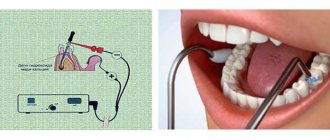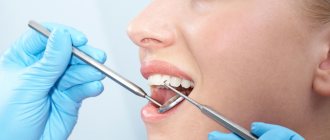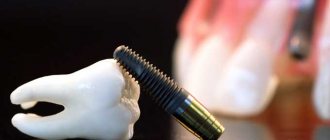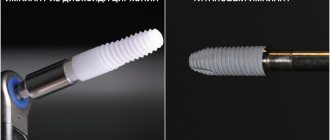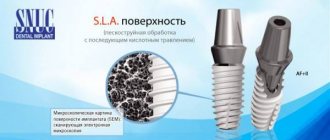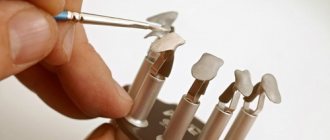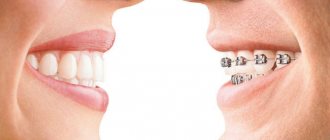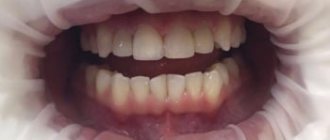There are a huge number of oral diseases. These include periodontal inflammation, caries, etc. However, until they get sick, few people voluntarily go to the doctor for a medical examination. Painful injections, scary drills, childhood psychological trauma after visiting the dentist - there can be a lot of reasons. And completely in vain. Dentistry is improving, new methods are emerging that make it possible to do everything quickly, discreetly and without harm to health. Dentist, Ph.D., told AiF.ru about what trends dominate dentists today and how teeth can be treated without the usual anesthesia with injections Dmitry Smirnov .
Article on the topic Before anesthesia. What did our ancestors use for anesthesia?
Implant systems
Implant systems are the best radical treatment method in dentistry. This technology allows for the highest quality replacement.
The essence of the technique is to implant a titanium pin into the bone, this makes it possible to restore not one tooth, but several at once. In addition, such a pin will be a reliable support for removable and fixed dentures.
The titanium pin is made from high-quality material that is sterile. The pins come complete with abutments, which serve as the basis for dentures and other structures.
It takes about 3 months for the implant to heal, during which it is densely overgrown with bone tissue around the perimeter, ensuring a super-strong connection.
No type of prosthetics can compare with the implant system in terms of aesthetic and functional qualities, as well as in terms of service life for the patient.
New technologies in dentistry
In the modern world, no one can be surprised by newfangled gadgets and technical innovations; they make our lives more comfortable, convenient and safer. Progress is the driver of the development of dentistry. Do you want to keep abreast of new technologies and advances in dentistry? Then our review is for you.
Vaccine against caries
For several years now, scientists have been developing vaccines against dental caries. There are currently five vaccine options ready to be tested over the next seven years.
All vaccines against dental caries have a suppressive effect on the bacterium Streptococcus mutans, which plays a major role in the development of dental caries. Constantly living in the mouth, bacteria produce lactic acid, which destroys enamel and leads to the formation of carious cavities in the tooth. Also, these bacteria are actively involved in the formation of tartar and the immediate inflammatory reaction in the tooth. The vaccine from British scientists contains antibodies to bacteria and operates according to the standard scheme: antibodies interact with microbes and destroy them.
Scientists are ready to begin clinical trials of the drug, but stipulate that it will take at least five years to obtain reliable results. This is due to the fact that caries develops slowly and takes several years to become clinically evident.
New ways to treat caries
Each treatment method has its own indications: modern doctors do not always use a drill. There are methods for treating superficial caries in the white or brown spot stage. There are methods of fluoride prevention, remotherapy, which restores the mineral composition of teeth, and ozone therapy. In the 21st century, the general trend of any therapy is to reduce invasiveness. Dentistry is no exception, so a number of new techniques are currently being used to reduce or completely eliminate the use of a drill.
Infiltration (caries treatment using ICON technology). A gentle, painless method that does not require strong mechanical impact on the tooth. Effective against caries in the spot stage. It consists of treating the tooth with a special innovative ICON resin, which kills pathogenic bacteria and fills the pores in the enamel. The procedure takes about 15 minutes.
Ozone therapy. Ozone is a natural antibiotic and a strong oxidizing agent, so it can quickly kill harmful bacteria and prevent their proliferation. Treatment of the problem area with ozone is effective for the treatment of caries in the spot stage, with fissure and molar superficial caries. For moderate and deep caries, ozone is used as an auxiliary disinfectant.
Laser treatment. The laser can partially replace the drill when removing carious tissue. The complete painlessness of laser treatment for dental caries is a myth, since the laser is effective only in the dentin layer, where it will inevitably touch the processes of the pulp. Therefore, even when using a laser, anesthesia is required. However, with its help it is quite possible to reduce the mechanical impact on the tooth.
Treatment without fear
Dentists have done a lot to stop people from being afraid of them. And they have achieved success - most patients no longer associate dental treatment with pain. Many innovations have come to the rescue. For example, dentists use technology developed just a couple of years ago. The patient is put on headphones with music, into which a special program developed at Harvard University is embedded. The signal allows the brain to work at a frequency characteristic of relaxation, falling asleep and meditation. In other clinics, patients are given gadgets so that they can watch their favorite TV shows right in the chair - this helps to take their minds off the noise during the procedure. And the most anxious guests, in the absence of contraindications, can always be offered sedation - the introduction of special drugs under the supervision of an anesthesiologist. It acts more gently than anesthesia and has no side effects.
Digital technologies in dentistry
Very high-quality treatment can be obtained from a doctor who works with optics - binoculars, special glasses with magnification. Because it is very important for a modern doctor to see the picture of treatment in detail. Most dental clinics buy microscopes. This, of course, improves the quality of treatment, but increases the cost.
In the next ten years, digital technologies will be introduced into dentistry, doctors are sure. Already now, instead of making impressions of the jaw and working with solutions before prosthetics, they scan the oral cavity and teeth using a special attachment that resembles an electric brush - and here on the screen is a 3D image of your smile. A scanner is not just a prestigious toy: every self-respecting dental clinic should have such equipment. And in general, the widespread use of 3D printers in dental treatment is just around the corner. To make veneers, crowns or aligners (polycarbonate trays), you will soon no longer need to wait for an answer from the laboratory - it will be installed on your dentist’s table.
Implantation and veneers
Finally, there has been a fundamental leap in the use of the implantation method. Implantation systems have appeared, thanks to the design of which the installation process does not require complex preparatory surgical measures. Even with a minimal amount of bone tissue, the healing process becomes almost invisible to patients. This has led to the fact that dental implantation is becoming a common procedure and does not cause fear in patients even over 70 years of age: the horror of the prospect of removable dentures is becoming a thing of the past.
Veneers are, of course, still a stable trend. And no wonder: if there is evidence, this is the easiest way to correct your smile. Manufacturers are experimenting with new materials to make dental “stickers” stronger or more beautiful. However, it is too early to judge their experiments, so dentists offer us classic and time-tested options. The choice depends on the condition of the oral cavity, but lithium disilicate veneers remain the most popular. At the same time, patients still choose dazzling white shades - it is usually extremely difficult to persuade them to more natural colors.
Peptides in dentistry
Today, peptides have a pronounced regenerative, anti-inflammatory, disinfectant effect, and stimulate microcirculation in periodontal tissues. Can be used continuously both for the prevention of periodontal disease, caries, the formation of tartar, and for strengthening the gums, increasing the resistance of the oral cavity to infections, treating bleeding, inflammatory processes in the oral cavity, periodontal disease, eliminating bad breath, restoring mineralization and increasing the caries resistance of tooth enamel .
The most pronounced regenerative effect of peptide drugs is observed with the combined use of toothpaste and elixirs for the oral cavity, especially in cases of impaired mineralization of tooth enamel, periodontal disease, atrophic processes of the gums and diseases of the oral mucosa.
Dentistry, as well as the oral care industry, is developing at a rapid pace. Do you know what else awaits you in the near future? Replenishment of the Revidont Professional line with innovative products. Which ones? You will learn about this very soon.
Modern removable dentures
There are systems that are installed in case of complete loss of dentition on one of the jaws. There are also clasp dentures that replace not the entire jaw, but some of its segments.
Previously, the raw material for production was acrylic, but this material did not have the necessary hygienic properties, and the service life of such a prosthesis was short. An innovative material in dentistry – soft and very durable nylon.
Nylon is not as dense a material as acrylic, but it is not able to absorb harmful odors, does not promote the proliferation of microorganisms and does not release harmful substances such as phenol into the oral cavity.
Another important property of nylon structures is that it does not cause rejection from the gum tissue and is ideally compatible with it. Modern removable dentures are not capable of causing an allergic reaction and have a short list of contraindications.
One of the disadvantages of this technology is its high price.
Stump tabs instead of pins
What other types of prostheses are used in dentistry? The topic of dental inlays is not fully covered in the previous paragraph of the article, because in addition to classic ones, doctors today also work with stump ones. But this is a slightly different story. Classic designs are only suitable when hard tissue is destroyed by 30-50%. And if the damage is more serious, then doctors suggest restoring the shape, beauty and functionality of the tooth with stump inlays.
The photo shows the stump tabs
Previously, in such clinical situations, dentists placed a pin to strengthen the root, walls and build up the top of the tooth from composite materials, or to install a crown. Today, much more advanced dentures – inlays – are used for this purpose. What are they? Made of metal, zirconium dioxide, ceramics. Unlike pins, they do not overload the root, distribute the chewing load evenly, and eliminate the risk of fracture.
You will find the most interesting facts about this type of design in the feature article on the website.
Modern clasp dentures
This is a structure that is represented by an arc on which the required number of implants is fixed. In this way, it is possible to replace a large number of teeth in one jaw, provided that the original healthy teeth still exist.
Clasp prosthetics are a heavy-duty design with a long service life. Disadvantages of the technology - the metal structure has many hooks and clasps, which does not allow the jaw to look aesthetically pleasing. Also, this type of prosthetics is characterized by a long adaptation period, but indisputable positive aspects should also be highlighted:
- Cheapness
- Easy to maintain structure.
- No negative effect on gum tissue.
Crowns for such prostheses can be made at the request of the patient. At this stage, the main materials are: ceramics, metal ceramics and porcelain.
Implantation using a surgical template
Modern dental implantation no longer involves such unpleasant aspects as prolonged psychological discomfort for the patient, a high likelihood of complications, risks, unknowns and much more, which, unfortunately, the pioneers of this area of dental treatment had to face. Today, cases of implant rejection are 5–2%, installation of one implant lasts on average 15 minutes, and the risk of medical error is minimized.
Perhaps the pinnacle of modern dental implantation can be considered the so-called surgical template for implantation. This term means precise and high-tech planning of the operation, eliminating even the minimal risk of medical error or difficulties during implantation. This technique is especially in demand in cases where the installation of several implants or the restoration of an entire row of teeth is required.
How is a surgical template created and what is it for? On the first visit, the patient undergoes a panoramic x-ray of the dentition - an orthopantomogram. Next, for several days the patient goes about his business, while his attending physician performs painstaking work - high-precision planning of the future operation. In a special laboratory, based on the patient’s orthopantomogram, a computer 3D model of the jaw is made, on which the implantologist calculates all options, assesses the proximity of neighboring roots, nerves, canals, etc. and draws up a plan for installing implants, taking into account the angles of inclination and all related factors. Roughly speaking, the doctor is already performing a full-fledged operation, but only on a virtual model.
Next, using this model, which is a surgical template, the dental technician makes plaster casts, and from them - temporary crowns that will be installed on the patient’s implants on the day of the operation.
Thus, thanks to the use of a surgical template, the doctor can calculate everything in advance and even “practice”, which, firstly, negates almost all risks, and secondly, saves the patient’s time and nerves.
Veneers, Lumineers and Ultraneers
Modern technologies for updating the aesthetic appearance of teeth are progressing every day, because everyone wants their smile to look perfect. One of the innovations is a ceramic overlay, which is called veneer.
Veneers allow you to whiten your teeth without exposure to acid, while also straightening them out and protecting damaged enamel.
Lumineers are an improved version of veneers, represented by high-quality ceramics of the thinnest layer, allowing application without preliminary grinding.
Ultraneers are also a ceramic overlay option that allows you to achieve stunning whiteness that would be the envy of Hollywood stars. Their main difference from veneers is that after removing this lining, the quality of the tooth will not remain at the same level, but will improve significantly, because the cement for ultra-veneers contains fluorine, which improves the properties of the enamel.
Surgical treatment takes up approximately 75% of all dental services. It is important that it is in this area that the main changes are taking place, which over time will become accessible to everyone.
Prosthetics
Previously, the process of installing crowns was painful and lengthy. The crowns were noticeable and spoiled the appearance of a person. The advent of metal-free ceramics, special scanners, tomography and 3D printers have significantly improved the situation: now artificial teeth do not differ in appearance from real ones. A three-dimensional photograph of the old tooth is first taken, which allows you to accurately create the appearance of the new ceramic one. After this, the prostheses are made with the highest quality and very quickly on special machines and are installed almost painlessly.
Dental treatment without using a drill
Many children, and often adults, are afraid to go to the dentist because of pain when using a drill. But now they can be reassured, because a completely new micro-abrasive technology is now being used.
What is its essence? In the supply of a pressurized air stream containing an abrasive powder, which acts selectively on tissue affected by caries, practically without affecting healthy areas. An ideal springboard for installing a filling is achieved. This procedure is completely painless and does not require additional anesthesia.
Stock
-6%
BASAL COMPLEX - Restoration of teeth on 1 jaw in 3 days 265,000 rub.
250,000 rub.
get -62 %
Metal-free dental crown made of zirconium dioxide 25,000 rub.
9500 rub.
get -10 %
Dental restoration All-on-4 RUB 310,000.
280,000 rub.
get -50 %
Treatment of stomatitis for the promotion of 10,000 rubles.
5000 rub. get
Dental treatment under sedation
Dentists are gradually abandoning full anesthesia for major surgery for adults or restless children. It is being replaced by sedative therapy. What is the difference? Anesthesia is a complete shutdown of the patient’s consciousness with the elimination of pain sensitivity. It is worth saying that such an operation has negative consequences.
Sedation is immersion in a shallow sleep without turning off consciousness using medications that do not cause addiction. Also, these drugs significantly raise the threshold of pain sensitivity, making the process of dental work completely insensitive. Sedative therapy has fewer contraindications and side effects, and the patient recovers much faster. This type of sedation allows for a large volume of dental procedures to be performed at once.
Liquid filling for a tooth
This technique in dentistry is also carried out without the use of a drill, but it is only possible in the initial stages of caries development. This operation is carried out in three stages:
- Destruction of carious tissue by exposure to acid-containing substances.
- Treat the resulting area with an alcohol solution.
- Application of a special infiltrate into the cavity, which subsequently hardens there.
According to doctors, such fillings last about 10 years.
Dental bridges
A bridge is a prosthetic option in which a semi-saddle or semi-oval structure is attached to healthy teeth adjacent to the space in which the prosthesis needs to be placed. Modern designs are cast entirely from metal or a combination of alloy and plastic or porcelain and contain no soldered components.
This makes it possible to achieve sufficient rigidity, minimal oxidation of the material, accurately reproduce the anatomy of the teeth, and ensure a tight fit of the bridge to them. All materials have anti-corrosion properties, do not irritate the mucous membranes, and do not react with saliva.
Bridge prosthesis on implants
Bridges are made without the use of acids and alkalis and prevent electrochemical processes in the oral cavity. They tightly wrap around the neck of the tooth and do not damage the gums, so they are well suited for small and medium-sized tooth defects and their pathological mobility associated with changes in tissues.
The advantage of this method is that you can choose non-toxic and hypoallergenic materials of various prices. Most often it is a metal alloy of gold, chromium-cobalt, palladium or silver, lined with porcelain or glass-ceramic.
Bridge with grinding of adjacent teeth
But its drawback is quite significant - it is the need to grind down adjacent teeth and remove the neurovascular bundle from them. However, this drawback has been overcome in the most modern bridges, which use special locks that are attached to the teeth without preliminary grinding.

